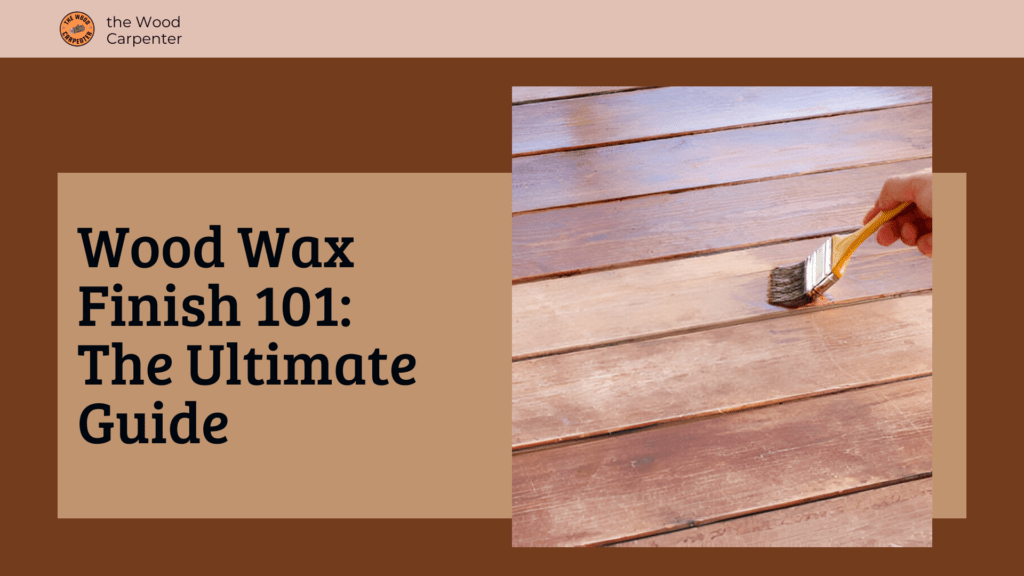
A wood wax finish is one of the oldest and most popular ways to protect and improve the look of wood. Whether you’re making furniture, doing a home project, or fixing up an old piece, knowing how wood wax works can help you give the wood a smooth, natural look and keep it safe for many years.
This easy guide will explain what a wood wax finish is, its good and bad points, different types of wax, how to apply it, how to care for it, and answers to common questions.
What is a Wood Wax Finish?
A wood wax finish is a thin layer of wax that protects and adds shine to wood. It can be made from natural waxes like beeswax or carnauba, or from man-made waxes like paraffin.
People have used wax on wood for hundreds of years to make it look nicer and to guard it against moisture and dust. Wax can be used on its own or on top of the other finishes like oil or shellac.
Types of Wood Wax
There are several types of wax used for finishing wood, each with unique properties:
Beeswax: Soft, easy to apply, and gives a gentle glow. It’s slightly sticky at the room temperature and has a pleasant scent.
Beeswax Wood Finish: The Secret to Stunning Wood
Carnauba Wax: Harder and more durable, produces a higher sheen, and is often blended with beeswax for improved performance.
Paraffin Wax: Soft, slick, and often used to modify other waxes. It’s colorless and odorless.
Paste Wax: A blend of waxes and solvents, easy to apply with a cloth, and commonly used on furniture.
Colored Waxes: Tinted with pigments to subtly alter or enhance the wood’s color while finishing.
Benefits of Wood Wax Finish
Wood wax finishes offer several unique advantages:
Natural Look and Feel: Wax enhances the natural beauty of wood grain, giving a warm, subtle sheen rather than a glossy or plastic-like appearance.
Silky-Smooth Texture: When buffed, wax creates a smooth, tactile surface that feels luxurious to the touch.
Easy Application: Wax finishes are forgiving and simple to apply, even for beginners. You can use a cloth, brush, or pad.
Repairability: If the finish is scratched or worn, simply reapply wax to the affected area and buff it out.
Low VOCs and Food Safety: Many waxes are low in volatile organic compounds and, once cured, are food-safe—making them ideal for cutting boards and utensils.
Water Resistance: Wax provides moderate protection against moisture, helping to prevent minor spills from soaking in.
Non-toxic: Most natural waxes are non-toxic, making them safe for use in homes and around food.
Ideal Uses for Wood Wax Finish
Wood wax finishes are versatile and can be used on a variety of surfaces:
Furniture: Chairs, tables, dressers, and cabinets.
Floors: Especially in low-traffic areas or older homes seeking a vintage look.
Wood Paneling and Trim: To maintain a natural, polished appearance.
Antiques: Preserves the integrity and authenticity of antique pieces.
Drawbacks of Wood Wax Finish
Despite its many benefits, wood wax finish does have some limitations:
Limited Durability: Wax is softer than varnish or polyurethane, so it wears away faster, especially on high-traffic surfaces.
Heat Sensitivity: Wax can be damaged by high temperatures, such as hot cups or pans.
Needs Regular Maintenance: To maintain its beauty and protection, wax must be reapplied periodically—usually once or twice a year.
Poor Chemical Resistance: Alcohol and strong cleaners can damage or remove the wax finish.
Not Suitable for All Surfaces: Wax is best for low-wear items like picture frames, carvings, and display cases, or as a topcoat over more durable finishes.
How to Apply a Wood Wax Finish
Putting on a wood wax finish is easy if you follow the steps carefully:
1. Get the Wood Ready
- Sand the wood well. Start with rough sandpaper and move to smoother ones (finish with 220–240 grit for furniture).
- Clean off all dust using a tack cloth or vacuum.
- Make sure the surface is clean, dry, and has no old finishes or oils.
2. Apply the Wax
- Use a clean, lint-free cloth, brush, or pad to spread the wax in thin, even layers. Always go with the grain of the wood.
- If using paste wax, take a small amount and rub it into the wood in small sections.
- Let the wax dry for 15 to 30 minutes. Follow the instructions on the product and consider the room’s humidity.
3. Buff the Surface
- After the wax dries, rub the surface with a clean, soft cloth or buffing pad to make it smooth and shiny.
- You can add more layers of wax for a deeper, richer look—just repeat the waxing and buffing steps.
4. Let It Cure
- Allow the waxed piece to sit and cure for several hours or even a few days.
- Some waxes take up to two weeks to fully harden.
Maintenance and Care
- Dust regularly with a soft cloth.
- Reapply a thin layer of wax as needed—typically every 6–12 months, or whenever the surface looks dull or feels dry.
- Avoid harsh cleaners or solvents, which can strip the wax.
- For minor scratches or wear, spot-apply more wax and buff.
Comparing Wood Wax to Other Finishes
| Feature | Wax Finish | Oil Finish | Polyurethane |
| Appearance | Soft, natural sheen | Matte to satin finish | Glossy or matte |
| Durability | Moderate | Moderate | High |
| Maintenance | Easy | Moderate | Difficult |
| Repairability | Easy to touch up | Moderate | Difficult |
| Application | Simple | Requires more drying | Involves multiple steps |
Frequently Asked Questions (FAQs)
Q: Is wood wax finish food-safe?
A: Most natural waxes, such as beeswax and carnauba, are food-safe once the solvents have evaporated, making them suitable for cutting boards and kitchenware.
Q: How often should I reapply wax to my wood furniture?
A: For most pieces, reapply wax every 6–12 months, or whenever the surface looks dull or feels dry.
Q: Can I use wood wax finish over other finishes?
A: Yes, wax can be used as a topcoat over oil, shellac, or other finishes to add sheen and extra protection.
Q: How do I remove a wax finish?
A: Use mineral spirits or a dedicated wax remover, followed by sanding if necessary, to strip wax from wood surfaces.
Q: Is wood wax finish waterproof?
A: Wax offers moderate water resistance but is not fully waterproof. Wipe up spills promptly to avoid damage.
Q: What’s the best way to buff a wax finish?
A: Use a soft, clean cloth or a buffing pad. Buff in the direction of the grain for best results.
Final Words
A wood wax finish is a classic and natural way to protect and improve the look of wood. It’s easy to put on, fix, and take care of, which makes it great for furniture, carvings, and decorations. Even though it’s not as strong as some modern finishes, many people love its soft feel and warm shine.
By learning about the different types of wax, how to apply them, and how to care for the finish, you can keep your wood looking beautiful for a long time.

